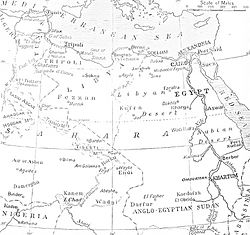
Back الحملة السنوسية Arabic سنوسی جبههسی AZB Campanya dels Senussi Catalan Campaña del Senussi Spanish Senusikapina Finnish Campagne Senussi French מרד הסנוסים HE Campagna dei Senussi Italian Kampania bractwa sanusijja w Egipcie Polish Campanha Senussi Portuguese
| Senussi campaign | |||||||
|---|---|---|---|---|---|---|---|
| Part of the North African theatre (First World War) | |||||||
 Area of operations, Senussi campaign | |||||||
| |||||||
| Belligerents | |||||||
|
Kaocen Rebels Supported by: | |||||||
| Commanders and leaders | |||||||
|
|
| ||||||
| Strength | |||||||
| Senussi: 10,000 (1915) |
Italy: 70,000 British Empire: 40,000 | ||||||
| Casualties and losses | |||||||
| c. 2,000 |
Italian: c. 11,000 (5,600 killed) British: c. 661 (117 killed and 544 wounded) | ||||||
| Non-battle casualties not counted | |||||||
The Senussi campaign took place in North Africa from November 1915 to February 1917, during the First World War. The campaign was fought by the Kingdom of Italy and the British Empire against the Senussi, a religious order of Arabic nomads in Libya and Egypt. The Senussi were courted by the Ottoman Empire and the German Empire. Recognising French and Italian threats, the Ottoman Sultan, Abdul Hamid II, had twice sent his aide-de-camp Azmzade Sadik El Mueyyed to meet Sheikh Muhammed El Mehdi El Senussi to cultivate positive relations and counter the west European scramble for Africa.[1][page needed] In the summer of 1915, the Ottomans persuaded the Grand Senussi, Ahmed Sharif as-Senussi, to declare jihad, attack British-occupied Egypt from the west and encourage insurrection in Egypt, to divert British forces.
The Senussi crossed the Libyan–Egyptian border in November 1915 and fought a campaign along the Egyptian coast. At first, British Empire forces withdrew, then defeated the Senussi in several engagements, culminating in the action of Agagia, followed the re-capture of the coast in March 1916. In the interior, the band of oases campaign continued until February 1917, after which a peace was negotiated and the area became a backwater for the rest of the war, patrolled by British aircraft and armoured cars.